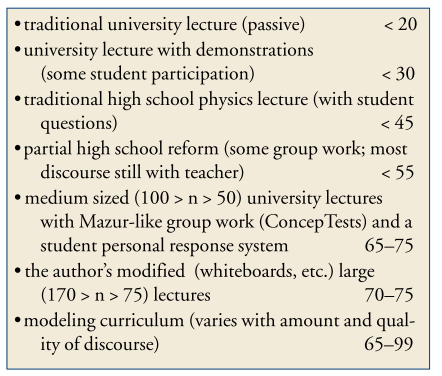Developed by Daiyo Sawada, Michael D. Piburn, Kathleen Falconer, Jeff Turley, and Irene Bloom
| Purpose | To measure the extent to which interactive and student-centered techniques are used in a given classroom. |
|---|---|
| Format | Observation protocol |
| Duration | N/A min |
| Focus | Teaching |
| Level | Graduate, Upper-level, Intermediate, Intro college, High school, Middle school, Other |
The following is a sample of the RTOP (specifically, the first cluster):
I. Lesson Design and Implementation
1. The instructional strategies and activities respected students' prior knowledge and the preconceptions inherent therein.
2. The lesson was designed to engage students as members of a learning community.
3. In this lesson, student exploration preceded formal presentation.
4. This lesson encouraged students to seek and value alternative modes of investigation or of problem solving.
5. The focus and direction of the lesson was often determined by ideas originating with students.
RTOP Developers Website, including the online version of an RTOP teacher workshop
RTOP YouTube channel, with training videos
more details
This is the highest level of research validation, corresponding to all seven of the validation categories below.
Research Validation Summary
Based on Research Into:
- Classroom behavior
Studied Using:
- Iterative observations
- Inter-rater reliability
- Training materials
Research Conducted:
- At multiple institutions
- By multiple research groups
- Peer-reviewed publication
The items on the RTOP were developed based on previous research and existing instruments. These initial items were used to observe video of classrooms by five experts, and the items were revised. The RTOP was tested with math faculty, and then substantially revised based on their feedback. The revised version was used to assess 17 twenty minute videotaped mathematics or science lessons, and inter-rater reliability calculated. The developers also created an "Annotated RTOP Guide" to document the growing inter-rater consensus about how each item should be interpreted. The RTOP was pilot tested with with 16 pairs of observations and inter-rater reliability calculated for the total score and the sub-scales. The RTOP has been used to observe over 400 K–20 science and mathematics classrooms, and the results are published in many peer-reviewed publications.
References
- S. Adamson, D. Banks, M. Burtch, F. Cox III, E. Judson, J. Turley, R. Benford, and A. Lawson, Reformed undergraduate instruction and its subsequent impact on secondary school teaching practice and student achievement, J. Res. Sci. Teaching 40 (10), 939 (2003).
- G. Aubrecht II, J. Esswein, J. Creamer, and B. Schmitt, Revealing Effects Of Changes In Middle School Science Teachers’ Practices, presented at the Physics Education Research Conference 2015, College Park, MD, 2015.
- T. Bartiromo and E. Etkina, Implementing Reform: Teachers’ Beliefs about Students and the Curriculum, presented at the Physics Education Research Conference 2009, Ann Arbor, Michigan, 2009.
- E. Close, Teacher Characteristics and Student Learning in Secondary Science, Seattle Pacific University, 2009.
- D. Desbien, Modeling Discourse Management Compared to Other Classroom Management Styles in University Physics, Arizona State University, 2002.
- E. Etkina, Pedagogical content knowledge and preparation of high school physics teachers, Phys. Rev. ST Phys. Educ. Res. 6 (2), 020110 (2010).
- S. Franklin and T. Chapman, Diversity of Faculty Practice in Workshop Classrooms, presented at the Physics Education Research Conference 2012, Philadelphia, PA, 2012.
- K. Gray, D. Webb, and V. Otero, Are Learning Assistants Better K-12 Science Teachers?, presented at the Physics Education Research Conference 2010, Portland, Oregon, 2010.
- K. Gray, D. Webb, and V. Otero, Effects of the learning assistant experience on in-service teachers' practices, presented at the Physics Education Research Conference 2011, Omaha, Nebraska, 2011.
- M. Haghanikar, S. Murphy, and D. Zollman, Evidence of students' content reasoning in relation to measure of reform, presented at the Physics Education Research Conference 2011, Omaha, Nebraska, 2011.
- T. Lund, M. Pilarz, J. Velasco, D. Chakraverty, K. Rosploch, M. Undersander, and M. Stains, The Best of Both Worlds: Building on the COPUS and RTOP Observation Protocols to Easily and Reliably Measure Various Levels of Reformed Instructional Practice, CBE Life. Sci. Educ. 14 (2), (2017).
- D. MacIsaac and K. Falconer, Reforming Physics Instruction Via RTOP, Phys. Teach. 40 (8), 479 (2002).
- D. Sawada, M. Piburn, E. Judson, J. Turley, K. Falconer, R. Benford, and I. Bloom, Measuring Reform Practices in Science and Mathematics Classrooms: The Reformed Teaching Observation Protocol, Sch. Sci. & Math. 102 (6), 245 (2002).
- C. Singh, L. Moin, and C. Schunn, Increasing interest and awareness about teaching in science undergraduates, presented at the Physics Education Research Conference 2005, Salt Lake City, Utah, 2005.
PhysPort provides translations of assessments as a service to our users, but does not endorse the accuracy or validity of translations. Assessments validated for one language and culture may not be valid for other languages and cultures.
| Language | Translator(s) | |
|---|---|---|
| Chinese | Weining Wu | |
| Japanese | Sachiko Tosa |
If you know of a translation that we don't have yet, or if you would like to translate this assessment, please contact us!
| Typical Results |
|---|
Typical scores for physics class taught with different teaching methods from MacIsaac and Falconer 2002:
Typical scores for math and science classes at different types of institutions from Sawada et al. 2002:
|
There is only one version of the RTOP.





